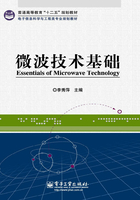
2.1 基本电路元件
电路的基本元件是电阻R、电容C和电感L。
电阻R:通过电阻的电流I等于外加电压除以其电阻值。这能视为电阻的定义。数学上写为

注意式(2.1)适用于直流电及任意一种时变波形。对交流信号,通过理想电阻的电流和两端的电压是同相的(如图2.1所示)。

图2.1 对于理想电阻R,交流电压V和电流I同相
不考虑电压和电流的时变性,电阻上消耗的瞬时功率是

式中,v(t)是元件两端的瞬时电压,i(t)是此刻通过电阻的电流。任意在正弦信号激励下的双端口元件的平均功率PAVG为

式中,V和I为电压和电流的峰值,θ为V和I相位的夹角。通常用均方根(rms)来描述电压和电流幅度值。通过均方根,相同幅值的直流电压或电流得到的平均功率是相同的。对正弦波,均方根值和峰值的关系为


和

【知识梳理】周期信号的有效值或均方值
“有效值”的概念是为了将周期信号(电压或电流)作用在负载电阻R上的平均功率Pav表示成等效的直流信号(电压或电流)的功率而提出的。因此,信号的有效值(Veff或Ieff)是它作用在负载电阻R上的实功率的一种度量。
为了求得信号的有效值,我们需要求出等效直流值(Veff或Ieff),它作用在负载电阻R上的功率Pav应等于周期信号的平均功率。因此,我们可以得到:
对于DC信号,有
对于周期信号,有

将v(t)Ri(t)=代入,并令上面两式相等,有



从上式可以看出,Ieff是电流的平方再取平均后的开方值(均方根值)。因此,有效电流Ieff通常指的是均方根电流值Irms,即
类似地,Veff的求解如下:



结论:由于Vrms=RIrms,于是可以得到


特例:正弦信号。当周期信号正弦变化时,即i(t)=Imcos(ωt),则Irms或Ieff可按下列方法求解:


或

或
对于i(t)=Imsin(ωt),其求解结果与上述一致:


注:



类似地,对于正弦电压有


其有效值(或均方根值)为

电感L:和电阻相比,理想电感L不会消耗功率。一般电感上的电压和通过它的电流的关系为

通过电感的瞬时电流通过积分运算得到:

存储在电感中的能量值UL等于其功率v(t)i(t)对时间的积分。设定通过它的电流i的起始条件为i=0:

积分得出瞬时存储能量为

通过电感的任意波形电流都和外加电压的积分成比例。采用正弦电压v(t)=V0cosωt,通过积分得到电流I。注意到对应直流电形式时的积分常数在处理交流电问题时可以忽略,这样就有

从欧姆定律可以看出电压除以电流得到的度量单位为欧姆,所以ωL的单位必须为“欧姆”。电感中没有能量的消耗。对相角为θ的直流电激励,电压和电流的夹角为-90°,如图2.2所示,其消耗的功率PDiss由如下公式给出:


图2.2 对于正弦激励,通过电感L的电流I的相位比电压V的相位滞后90°
电容C:和电感一样,电容C也不消耗能量。在这种情况下与其说它存储电荷,不如说它存储能量。按定义,电容C是瞬时电荷q和存储电荷的瞬时电压v(t)的比值,电荷被存储于此:

电流流进电容时,存储的电荷增加。q随时间的变化率等于电流,式(2.32)两边都乘以v,然后分别对t求偏导得

分别对t积分得

当直流电通过电容时,电容两端的电压是从电容器为0电压开始对电流的积分。电容器不消耗功率,而且还能存储能量。能量的存储可以视为一个电势场里存在电荷或者电容器平行板间存在电场。对最开始不带电的电容即v(0)=0,在电压V对电容充电时,传给电容的瞬时功率即v(t)i(t)关于t的积分,是电容存储的能量UC:

整理得瞬时存储的能量为

这个结果不依赖于用来存储电荷的电压电流波形。在用正弦电压时,电流波形也是正弦且相位超前90°,如图2.3所示。

图2.3 对于正弦激励,通过电容C的电流I的相位比电压V的相位超前90°


从式(2.38)可以推出1/ωC的单位为欧姆,同样ωL的单位也是欧姆。